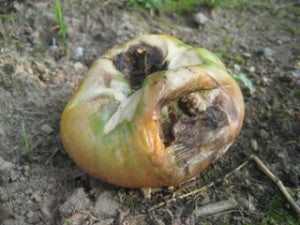Blight has been with us a long, long time. Remember the Irish Potato Famine? No? That’s because it was the blight of 1845 and you weren’t born yet. But the spores were.
 TOMATO CULTURE: A PRACTICAL TREATISE ON THE TOMATO, ITS HISTORY, CHARACTERISTICS, PLANTING, FERTILIZATION, CULTIVATION IN FIELD, GARDEN, AND GREENHOUSE, HARVESTING, PACKING, STORING, MARKETING, INSECT ENEMIES AND DISEASES, WITH METHODS OF CONTROL AND REMEDIES, ETC., ETC. By WILL W. TRACY Bureau of Plant Industry, USDA NEW YORK 1907
TOMATO CULTURE: A PRACTICAL TREATISE ON THE TOMATO, ITS HISTORY, CHARACTERISTICS, PLANTING, FERTILIZATION, CULTIVATION IN FIELD, GARDEN, AND GREENHOUSE, HARVESTING, PACKING, STORING, MARKETING, INSECT ENEMIES AND DISEASES, WITH METHODS OF CONTROL AND REMEDIES, ETC., ETC. By WILL W. TRACY Bureau of Plant Industry, USDA NEW YORK 1907The blight of 2009 was so bad that Governor Patterson and Senators Gillibrand and Schumer declared the outbreak an agricultural disaster and asked the federal government for disaster relief aid. It was so bad that the world’s top potato producers freaked out a bit and stepped up their efforts to create certified organic treatments to control blight. Until those new products are available, what can you do about blight?
Many of we tomato-loving farmers and gardeners are devastated this August. During a month that ordinarily finds kitchens filled with piles of luscious red fruits, this year many of us are engaged in tomato triage. We snag a decent Brandywine here, a couple Mama Leones there--but our eyes are full of the destruction wrought by this year's pernicious fungal interloper. You could say we have blight on the brain.
No one is taking this rotten infestation blightly--especially not us, as we've lost most of our once-beautiful plants. But what's the use of sitting around crying "Spore me! Spore me!"? No matter how bleak things seem, we believe it's im(s)portant to look on the blight side of life. So we've made these spore-tee t's to help us all face down our sporaphobia and take the bite out of blight.
Spores got you spooked? Hating the blotched harvest? Crying over spore-adic gleanings? Have life-sucking spores spoiled your summer? Need someone to blame?
Meet Blightee: the not so adorable, entirely inedible, terrible tomato whose air-borne sporacious sporangia have turned our tasty summer bounty into mush.
We're tired of being pushed around by a bunch of over blown sporangiophores, and we say, resoundingly, that Blight Does Not Make Right!
Join us. Bite back by spore-ting this tee that says it all: Blight Bites! Each shirt features the "Blight Bites" image front and center with a very small Hudson Valley Seed Library logo on the sleeve. The American Apparel brand shirts are made in America and woven from 100% organic cotton; the printing is done by Antilogy Designs in Tillson, New York. The logo is based on a design created by Michael Wilcock.
A s-portion of the proceeds from these tees goes towards developing blight resistant open-pollinated tomato varieties through good old fashioned seed saving.
 Blight Me!
Blight Me!Here in the Northeast, late blight is with us every year. This year, due to the cool temperatures and heavy rains, blight was able to spread unchecked. In June we had # and in July we had #. Here are a few ways (other than supporting our work by buying this organic cotton, American made, locally printed, hand illustrated, cathartic t-shirt) you can avoid or slow down blight.
1. Start your tomatoes from seed or buy organic starts from local farmers.
2. Water the soil beneath your plants instead of with overhead sprinklers.
3. Plant in raised beds and mulch with clean dry materials.
4. Prune tomato plants so that when it does rain, no leaves are getting back splash from the soil.






